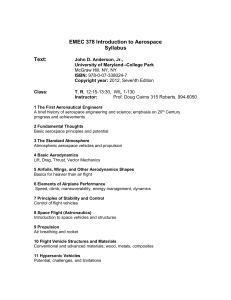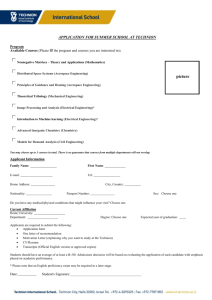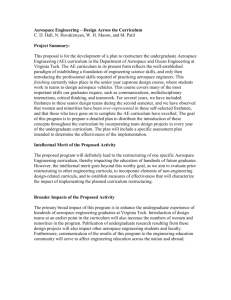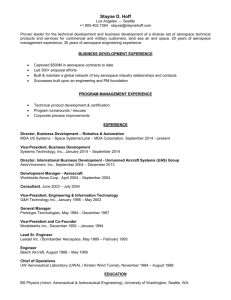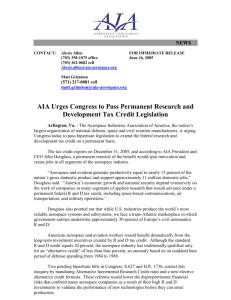INTERNATIONAL AIR CARGO & BAGGAGE
advertisement
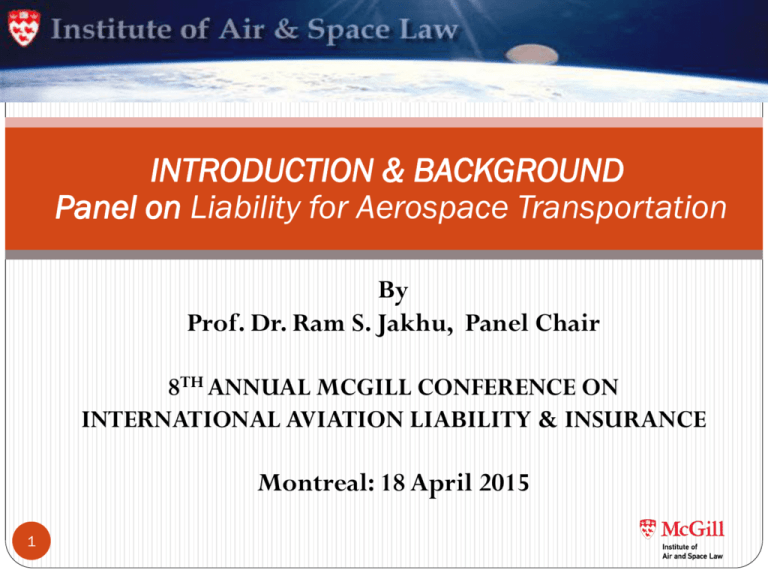
INTRODUCTION & BACKGROUND Panel on Liability for Aerospace Transportation By Prof. Dr. Ram S. Jakhu, Panel Chair 8TH ANNUAL MCGILL CONFERENCE ON INTERNATIONAL AVIATION LIABILITY & INSURANCE Montreal: 18 April 2015 1 Introduction & Background Aerospace transportation refers to carriage by vehicles that are capable of seamless operation within both airspace and outer space. Aerospace vehicles will soon be transporting people and cargo/payloads on suborbital flights as well as from point-to-point on the surface of the Earth through outer space. Aerospace vehicles could be subject two different legal regimes, (i.e. aviation law and law of outer space) . Application of this dual legal regime would cause confusion in 2 determining liability in case of: injury to or death of passengers and/or damage to cargo/payloads caused during aerospace transportation, on the surface of the Earth, in air and in outer space. Emerging Commercial Aerospace Transport Industry VIRGIN GALACTIC WEBSITE: 700Virgin Galactic astronauts signed up with tickets cost of $250,000 each. FAA’s Office of Commercial Space Transportation told the U.S. House Subcommittee on Space and Aeronautics (20 March 2012): 3 space tourism could be “a $1-billion industry within the next 10 years.” Start of Affordable Routine Aerospace Transportation On 21 June 2004, SpaceShipOne was taken to an altitude of 15 Km by a custom-made transport aircraft White Knight. From there, it fired its rocket engine for a vertical rise at a speed of 3,500 km per hour to reach an altitude of about 104 Km to be in outer space SpaceShipOne and its pilot Mike Melvill (62 years of age) remained 3 minutes in space before returning to land horizontally at Mojave airport like an aircraft This was the first successful sub- orbital flight 4 Various aerospace vehicles are being developed 5 Various aerospace vehicles are being developed 6 Commercial spaceports are being constructed The US: An aerial view shows the Oklahoma Spaceport's 13,503foot-long runway. Singapore Sweden The United Arab Emirates Others… 7 http://news.yahoo.com/investigators-branson-spacecraft-crash-072616071.html 2 November 2014 (sadly accidents could and would happen) 8 Internationalization of aerospace transportation Like aircraft, aerospace vehicles most likely would be developed and manufactured by a small group of countries. By constructing and operating appropriate ground facilities (spaceports), all nations could/would participate in aerospace transportation. Aerospace vehicles will soon be ‘flying’ not only domestically but also on international routes from and to different countries. Travel from Montreal to Tokyo in 2 hours by 2020 ? Most probably View from ICAO (2010): During sub-orbital or orbital flights if aerospace vehicles cross foreign airspaces, the 1944 Chicago Convention and its pertinent Annexes, “would in principle be amenable to their regulation.” ICAO/UNOOSA Aerospace Symposium on 18-20 March 2015 9 Passenger liability The U.S. is the only country that has adopted specific national legal regime specifically regulating aerospace transportation. Under, the U.S. Commercial Space Launch Act, as amended in 2004, aerospace vehicles are space objects and travelers in these vehicles are “space flight participants” (SFP) The U.S. law includes a provision regarding a waiver of compensation claim by a SFP thereby excluding liability of the space flight operator. To be entitled to such a waiver, a space flight operator must inform and seek “informed consent” from each space flight participant about the risks involved in such a flight. 10 Passenger liability • HOWEVER, the U.S. law might not helpful in excluding the liability of the aerospace transport operators involved in international flights and national flights in other countries. • In such cases, the issue of passenger liability may be governed by applicable international treaties and/or foreign law. E.g.: The Warsaw Convention (as amended) or the Montreal Convention, that applies to aircraft involved in international transportation; or The 1972 Liability Convention that applies to space vehicles using rocket propulsion (space object, including launch vehicle) Applicable laws of various countries, if any…… 11 Main Issues to be Addressed In case of Commercial Space Launch Accidents: Who Pays? What are the liability implications for suborbital space travel? In the USA, what role does FAA play in Financial Responsibility and Informed Consent? Safety And Liability Regulation Of Aerospace Flights In Europe Does ICAO have jurisdiction to address suborbital flight, and should it? 12 Panelists CHAIR: Ram Jakhu - Associate Professor, Institute of Air and Space Law, Faculty of Law, McGill University - CANADA SPEAKERS: Laura Montgomery – Manager, Space Law Branch, Office of the Chief Counsel, Federal Aviation Administration, Washington, DC, USA (“The FAA’s Role in Financial Responsibility and Informed Consent”) Pamela Meredith – Attorney with Zuckert, Scoutt & Rasenberger, Washington, DC, USA; specialises in commercial space transactions, legal risk management and space insurance, space licensing and regulation (“Commercial Space Launch Accidents: Who Pays?” ) Michael Chatzipanagiotis – Attorney at Law, Athens, Greece; specializes in aviation, space and IP law. (“Exploring The Labyrinth: Safety And Liability Regulation Of Aerospace Flights In Europe”) 13 THANK YOU FOR YOUR ATTENTION Thank you 14

